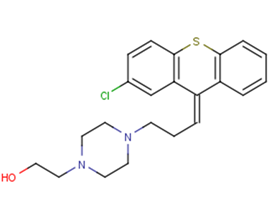
Zuclopenthixol
CAS No. 53772-83-1
Zuclopenthixol( alpha-Clopenthixol | Clopenthixol | Zuclopenthixol )
Catalog No. M18758 CAS No. 53772-83-1
Zuclopenthixol is a thioxanthene with therapeutic actions similar to the phenothiazine antipsychotics. It is an antagonist at D1 and D2 dopamine receptors.
Purity : >98% (HPLC)
 COA
COA
 Datasheet
Datasheet
 HNMR
HNMR
 HPLC
HPLC
 MSDS
MSDS
 Handing Instructions
Handing Instructions
| Size | Price / USD | Stock | Quantity |
| 25MG | 27 | In Stock |


|
| 50MG | 35 | In Stock |


|
| 100MG | 50 | In Stock |


|
| 200MG | 72 | In Stock |


|
| 500MG | Get Quote | In Stock |


|
| 1G | Get Quote | In Stock |


|
Biological Information
-
Product NameZuclopenthixol
-
NoteResearch use only, not for human use.
-
Brief DescriptionZuclopenthixol is a thioxanthene with therapeutic actions similar to the phenothiazine antipsychotics. It is an antagonist at D1 and D2 dopamine receptors.
-
DescriptionZuclopenthixol, also known as Cisordinol, Clopixol, Acuphase, zuclopentixol, is a typical antipsychotic drug of the thioxanthene class. It was introduced in 1962 by Lundbeck. Zuclopenthixol is the cis-isomer of clopenthixol. Zuclopenthixol is not approved for use in the United States. Zuclopenthixol has high affinity for both dopamine D1 and D2 receptors, for α1-adrenoceptors and 5-HT2 receptors but no affinity for cholinergic muscarine receptors. It has weak histamine (H1) receptor affinity and no α2-adrenoceptor blocking activity.(In Vivo):After acute treatment, Zuclopenthixol (0.2 and 0.4 mg/kg)-treated animals exhibit ethopharmacological profiles characterized by a decrease in offensive behaviors without impairment of motor activity (0.2 mg/kg). In contrast, the antiaggressive action of the highest dose used (0.4 mg/kg) is accompanied by a marked increase of immobility. After subchronic treatment, no tolerance to Zuclopenthixol antiaggressive or motor activity is observed.Administration of Zuclopenthixol (0.7 and 1.4 mg/kg) significantly elevate MDA level compared to respective controls. Nevertheless, there is no difference between the two dose levels with respect to their effect on rat brain MDA level. Post hoc pairwise comparisons between the means of groups (n=12) receiving different dose levels of Zuclopenthixol reveal that administration of 1.4 mg/kg of Zuclopenthixol significantly reduces GSH level compared to both vehicle-treated and Zuclopenthixol (0.7 mg/kg)-treated animals (P<0.001). Nevertheless, the lower dose of the drug does not affect rat brain GSH level. Animals receiving 0.7 or 1.4 mg/kg of Zuclopenthixol exhibits significantly higher GSH levels than SCO treated animals. Administration of 0.7 mg/kg of Zuclopenthixol significantly elevated GSHPx activity compared to vehicle treated animals.
-
In Vitro——
-
In VivoAfter acute treatment, Zuclopenthixol (0.2 and 0.4 mg/kg)-treated animals exhibit ethopharmacological profiles characterized by a decrease in offensive behaviors without impairment of motor activity (0.2 mg/kg). In contrast, the antiaggressive action of the highest dose used (0.4 mg/kg) is accompanied by a marked increase of immobility. After subchronic treatment, no tolerance to Zuclopenthixol antiaggressive or motor activity is observed. Administration of Zuclopenthixol (0.7 and 1.4 mg/kg) significantly elevate MDA level compared to respective controls. Nevertheless, there is no difference between the two dose levels with respect to their effect on rat brain MDA level. Post hoc pairwise comparisons between the means of groups (n=12) receiving different dose levels of Zuclopenthixol reveal that administration of 1.4 mg/kg of Zuclopenthixol significantly reduces GSH level compared to both vehicle-treated and Zuclopenthixol (0.7 mg/kg)-treated animals (P<0.001). Nevertheless, the lower dose of the drug does not affect rat brain GSH level. Animals receiving 0.7 or 1.4 mg/kg of Zuclopenthixol exhibits significantly higher GSH levels than SCO treated animals. Administration of 0.7 mg/kg of Zuclopenthixol significantly elevated GSHPx activity compared to vehicle treated animals.
-
Synonymsalpha-Clopenthixol | Clopenthixol | Zuclopenthixol
-
PathwayOthers
-
TargetOther Targets
-
RecptorD1| D2
-
Research Area——
-
Indication——
Chemical Information
-
CAS Number53772-83-1
-
Formula Weight400.96
-
Molecular FormulaC22H25ClN2OS
-
Purity>98% (HPLC)
-
SolubilityDMSO : ≥ 150 mg/mL; 374.10 mM
-
SMILESC1CN(CCN1CC/C=C\1/c2ccccc2Sc2c1cc(cc2)Cl)CCO
-
Chemical Name2-[4-[(3Z)-3-(2-chlorothioxanthen-9-ylidene)propyl]piperazin-1-yl]ethanol
Shipping & Storage Information
-
Storage(-20℃)
-
ShippingWith Ice Pack
-
Stability≥ 2 years
Reference
1.Khalifa AE: Zuclopenthixol facilitates memory retrieval in rats: possible involvement of noradrenergic and serotonergic mechanisms. Pharmacol Biochem Behav. 2003 Jul;75(4):755-62.
molnova catalog



related products
-
1-Phenyl-1,2-ethaned...
O-benzyl oxime ether derivatives and their use as pesticides.
-
3,4-(Methylenedioxy)...
3,4-(Methylenedioxy)cinnamic acid is a plant-derived compound first extracted from roots of Asparagus officinalis and further characterized as an allelochemical.
-
Auraptene
Auraptene is a coumarin derived from citrus plants that bears a geranyloxyl moiety at its C-7.



 Cart
Cart
 sales@molnova.com
sales@molnova.com


